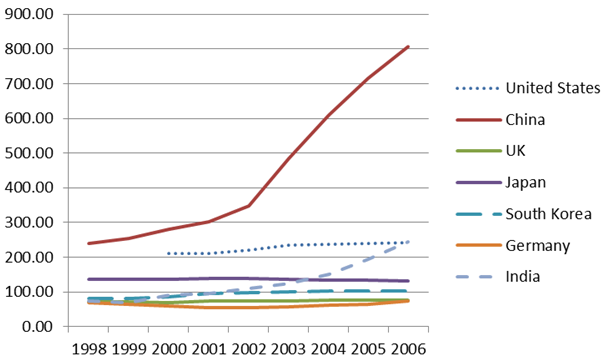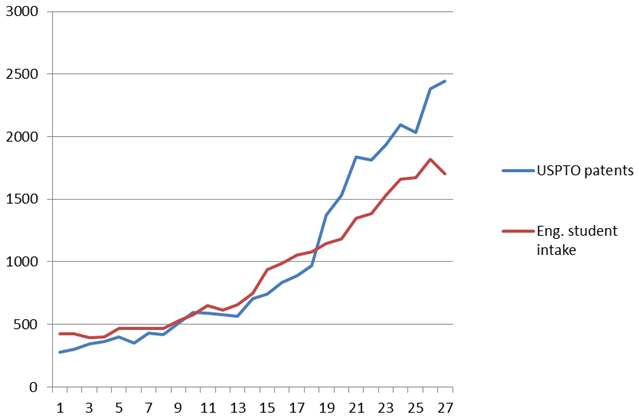There is a broad, research-based consensus amongst academic researchers, policymakers and pundits that the key to economic growth lies in improving productivity. There is also wide agreement that productivity increases come through innovation. As Charles Jones argues: “[t]he more inventors we have, the more ideas we discover, and the richer we all are” (2005). This immediately leads to the following policy question: (how) can the number of inventors be increased? This question is all the more pressing given the current pressures on public-sector finances, and the rising costs of obtaining university education.
New research
In Toivanen and Väänänen (2013), we seek to answer this question by studying whether obtaining a master’s-level engineering degree has a causal impact on individuals obtaining US patents. To answer this question, we resort to individual-level data from Finland, and couple it with data for US patents by Finnish inventors, and data on the transformation of Finnish university-level engineering education in the latter half of the 20th century.
Engineering education is a natural focus of our study for two reasons:
- First, there is ample evidence that inventors (of patents) are often engineers (e.g. the PatVal survey, see Giuri et al. 2007).
- Second, several emerging economies – India and China foremost among them – have chosen to invest heavily in engineering and science education.
Figure 1 demonstrates these trends.
Figure 1. Science and Engineering graduates in selected countries
Notes: Source for all other countries but India NSF Science and Engineering Indicators 2010, Figure O-8. See http://www.nsf.gov/statistics/seind10/figures.htm. For India, the source is Banerjee and Muley 2008.
We used Finland for our study because, among OECD countries, it is the country with the highest proportion of engineers: 27% of the Finnish working-age population with tertiary education has a degree in engineering whereas the OECD average is 15% (OECD 2008). This fact is coupled with the observation (Trajtenberg 2001) that Finland is among those nations that have accomplished a transformation from a resource based to an invention based economy. This is reflected in the large increase in Finnish patent applications to the USPTO in the past two decades.
In terms of descriptive analysis, Figure 2 is instructive: it shows the number of US patents awarded to Finnish inventors, and the intake into university level (master’s) engineering education in Finland. The catch of the figure is that the two highly correlated graphs (correlation coefficient 0.98) are from different periods: the patent series is from 1981-2007, the intake of engineering students from 1951-77. While the (choice of) timing of the time-series is obviously open to criticism, it demonstrates that at the aggregate level, there is some reason to think that there could be a relationship between a policy that was implemented from the 1950s to the 1970s and outcomes measured in the 1990s.
Figure 2. USPTO patents and Engineering student intake at universities
In Toivanen and Väänänen (2013) we go further and utilise the changing geographical proximity of university level engineering education as a so-called quasi-natural experiment to identify the causal impact of engineering education on the propensity to patent. We find a strong causal impact of engineering education on invention. Our results also suggest that the inventors are not your ‘run-of-the-mill’ engineers. Rather, they are individuals whose likelihood of entering engineering education is lower than average.
Conclusions
Our answer to the policy question is thus affirmative: yes, the number of inventors can be increased through educational policy. Our calculations suggest that if Finland had not established the new engineering universities in the postwar era, the number of US patents obtained by Finnish inventors would have been 20% lower. Our results provide a justification for the policies adopted by emerging economies, and to the worries raised e.g. in the US about the decline of interest in engineering and science studies (see e.g. Burrelli and Rapoport 2009; Freeman 2006, 2010), though further research would be needed to establish whether our results hold outside the postwar Finnish environment.
References
Burrelli, J, and Rapoport, A (2009), “Reasons for International Changes in the Ratio of Natural Science and Engineering Degrees to College-Age Population”, National Science Foundation Infobrief NSF 09-308.
Freeman, R (2006), “Does Globalization of the Scientific/Engineering Workforce Threaten US Economic Leadership?” in Jaffe, Adam, Lerner, Josh, and Stern, Scott (eds.) Innovation Policy and the Economy 6, NBER and MIT Press.
Freeman, R (2010), “What Does the Global Expansion of Higher Education Mean for the US?” in Clotfelter, Charles (ed.) American Universities in a Global Market, Chicago University Press.
Giuri P, Mariani M, Brusoni S, Crespi G, Francoz D, Gambardella A, Garcia-Fontes W, Geuna A,Gonzales R, Harhoff D, Hoisl K, Lebas C, Luzzi A, Magazzini L, Nesta L, Nomaler Ö, Palomeras N, Patel P, Romanelli M, Verspagen B (2007), “Inventors and Invention Processes in Europe. Results from the PatVal-EU Survey”, Research Policy 36(8), 1107-1127.
Jones, C (2005), “Growth and Ideas”, Chapter 16 in Aghion P and S Durlauf (eds.) Handbook of Economic Growth 1B, Elsevier BV.
Toivanen, O and L Väänänen (2011), “Education and Invention”, CEPR Discussion Paper. 8537, August.
Trajtenberg, Manuel (2001), “Innovation in Israel 1968–1997: a Comparative Analysis Using Patent Data”, Research Policy 30(3), 363-389.





